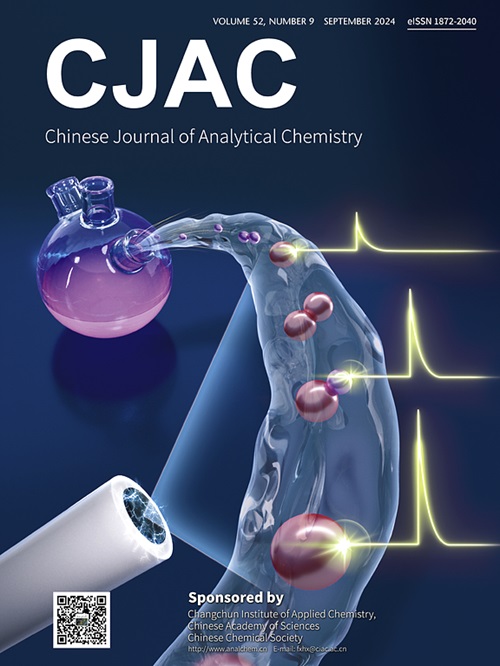Study on the anti-colon cancer effect of Renshen Yangrong decoction based on network pharmacology, molecular docking, and in vivo and in vitro experiments
IF 1.2
4区 化学
Q4 CHEMISTRY, ANALYTICAL
引用次数: 0
Abstract
Renshen Yangrong Decoction (RSYRD) is a traditional Chinese medicinal compound widely used as an adjuvant in colon cancer treatment. However, the specific role of RSYRD in anti-colon cancer remains unclear. This study aimed to investigate the anti-colon cancer effects of RSYRD using network pharmacology, molecular docking, and in vitro and in vivo experiments. The active ingredients and targets of RSYRD were identified utilizing databases, and RSYRD-ingredient-target and protein-protein interaction (PPI) networks were constructed. Gene Ontology (GO) functional analysis and Kyoto Encyclopedia of Genes and Genomes (KEGG) enrichment analysis were performed on the anti-colon cancer targets of RSYRD, followed by molecular docking using AutoDockTools 1.5.6. In vitro and in vivo experiments were conducted to explore the mechanism of RSYRD and evaluate its inhibitory efficacy on colon cancer. A total of 233 active ingredients and 88 colon cancer-related targets were identified, including 9 core targets. GO functional analysis revealed that RSYRD exerts anti-tumor effects through processes such as oxidative reactions, closely associated with intracellular reactive oxygen species (ROS). KEGG enrichment analysis indicated that the anti-tumor effect of RSYRD involved the interaction of cancer-related and viral disease-associated pathways, as well as the IL-17, TNF, and PI3K-AKT signaling pathways. Molecular docking showed stable ligand-receptor binding, with binding energies below −5.0 kcal/mol. In vitro experiments demonstrated that RSYRD increased ROS levels, reduced mitochondrial membrane potential (MMP), and promoted apoptosis in SW620 cells, thereby inhibiting cell proliferation and migration. In vivo experiments showed that RSYRD significantly suppressed colon cancer proliferation. This study identified Quercetin, Kaempferol, 7-Methoxy-2-methyl-isoflavone, Licochalcone-a, and Isorhamnetin as core ingredients in RSYRD, likely exerting anti-colon cancer effects by inhibiting proteins such as ESR1, HSP90AA1, NCOA2, and MAPK14, and suppressing the PI3K-AKT signaling pathway, thereby regulating tumor cell proliferation, migration, and apoptosis.

基于网络药理学、分子对接、体内外实验的人肾养荣汤抗结肠癌作用研究
人肾养荣汤是一种广泛应用于结肠癌辅助治疗的中药复方。然而,RSYRD在抗结肠癌中的具体作用尚不清楚。本研究旨在通过网络药理学、分子对接、体外和体内实验等方法探讨RSYRD的抗结肠癌作用。利用数据库鉴定RSYRD的有效成分和靶点,构建RSYRD-成分-靶点和蛋白-蛋白相互作用(PPI)网络。对RSYRD的抗结肠癌靶点进行基因本体(GO)功能分析和京都基因基因组百科全书(KEGG)富集分析,然后使用AutoDockTools 1.5.6进行分子对接。通过体外和体内实验,探讨RSYRD的作用机制,评价其对结肠癌的抑制作用。共鉴定出233种有效成分和88种结肠癌相关靶点,其中包括9种核心靶点。氧化石墨烯功能分析表明,RSYRD通过氧化反应等过程发挥抗肿瘤作用,与细胞内活性氧(ROS)密切相关。KEGG富集分析表明,RSYRD的抗肿瘤作用涉及癌症相关和病毒疾病相关通路,以及IL-17、TNF和PI3K-AKT信号通路的相互作用。分子对接表现出稳定的配体-受体结合,结合能低于- 5.0 kcal/mol。体外实验表明,RSYRD可提高SW620细胞的ROS水平,降低线粒体膜电位(MMP),促进细胞凋亡,从而抑制细胞增殖和迁移。体内实验表明,RSYRD能显著抑制结肠癌的增殖。本研究发现槲皮素、山奈酚、7-甲氧基-2-甲基异黄酮、甘草查尔酮-a和异鼠李素是RSYRD的核心成分,可能通过抑制ESR1、HSP90AA1、NCOA2、MAPK14等蛋白,抑制PI3K-AKT信号通路,从而调控肿瘤细胞的增殖、迁移和凋亡,发挥抗结肠癌作用。
本文章由计算机程序翻译,如有差异,请以英文原文为准。
求助全文
约1分钟内获得全文
求助全文
来源期刊
CiteScore
3.60
自引率
25.00%
发文量
17223
审稿时长
35 days
期刊介绍:
Chinese Journal of Analytical Chemistry(CJAC) is an academic journal of analytical chemistry established in 1972 and sponsored by the Chinese Chemical Society and Changchun Institute of Applied Chemistry, Chinese Academy of Sciences. Its objectives are to report the original scientific research achievements and review the recent development of analytical chemistry in all areas. The journal sets up 5 columns including Research Papers, Research Notes, Experimental Technique and Instrument, Review and Progress and Summary Accounts. The journal published monthly in Chinese language. A detailed abstract, keywords and the titles of figures and tables are provided in English, except column of Summary Accounts. Prof. Wang Erkang, an outstanding analytical chemist, academician of Chinese Academy of Sciences & Third World Academy of Sciences, holds the post of the Editor-in-chief.

 求助内容:
求助内容: 应助结果提醒方式:
应助结果提醒方式:


